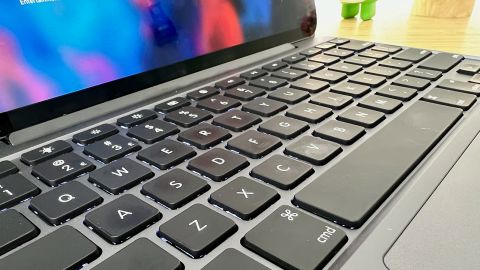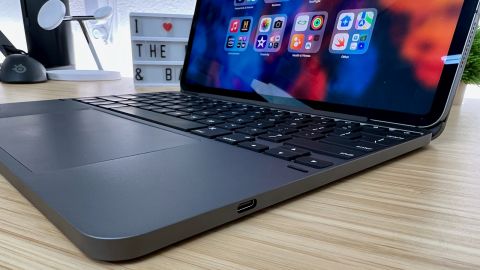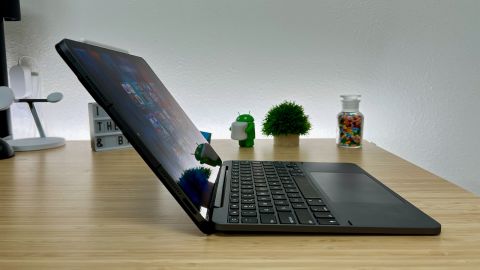The debate about whether or not Apple’s iPad Pro can replace your laptop isn’t going to stop any time soon. My advice? Use Apple’s biggest tablet however you see fit. For me, that means using it just like I would a MacBook, complete with a keyboard and trackpad.
I typically use Apple’s $350 Magic Keyboard for the iPad Pro, but for the last couple of weeks I’ve been testing out the more affordable $250 Brydge Max+ for iPad Pro. The Max+ does everything Apple’s keyboard can, and even does some things it can’t, making it an alternative option for those who can’t stomach spending $350 on an accessory.
The who, what and how
Who it’s for: The Brydge Max+ for iPad Pro is for someone who wants to use an iPad more like a laptop. It’s a full size keyboard with a trackpad that makes it easy to navigate iPadOS, as well as type long papers, emails or spend time chatting in Messages.
What you need to know: The Brydge Max+ comes in three different colors, and costs $250. It uses Bluetooth 5.0 to communicate with the iPad Pro, but doesn’t suffer from lag or excessive battery drain thanks to custom firmware.
How it compares: Apple’s Magic Keyboard for the iPad Pro costs $350, but connects directly to the iPad Pro through Apple’s Smart Connector on the back of the tablet. The Brydge Max+ works in a similar fashion to any Bluetooth keyboard, but with customized firmware to ensure fast connectivity and that touchpad gestures are seamless. In addition to adding a keyboard and trackpad, the Max+ adds a layer or protection, doubling as a case – something the Magic Keyboard does, only it’s not as protective.
It’s clear where Brydge got its inspiration for the design of the Max+ keyboard — Apple’s MacBook line. The housing is a slightly darker space gray color, and the keys, albeit thicker, look just like what you’d find on a MacBook. The same can be said about the trackpad that’s just below the keyboard — it looks just like the MacBook’s.
At the top of the keyboard is a row of function keys, each one with its own purpose. For example, there’s a home button, a button that instantly locks your iPad, another button to adjust keyboard brightness, media controls and a power button. The power button has a small LED indicator light built into it that lets you know when the keyboard is in pairing mode, or running low on battery.


Using the Max+ keyboard for the last week has made me wish Apple’s Magic Keyboard had a row of function keys, like the Max+ has. Apple’s Magic Keyboard doesn’t have any of that; it’s a keyboard with the least amount of keys possible, for better or worse. Without a row of function keys, you either have to reach up and swipe down in the top-right corner of the display to view Control Center, where things like media controls are kept, or use the trackpad to interact with the same interface. Having function buttons directly on the keyboard allow you to quickly hit play/pause, adjust screen brightness or volume while keeping your hands on the keyboard.
Attached to the hinge is a backplate that has a cutout for the iPad Pro’s rear camera. The plate has several magnets in it to hold the iPad in place as you adjust viewing angles. The Max+ is just as easy to adjust as the Magic Keyboard, but it offers a wider range of viewing angles. The magnets are strong and take some effort to peel the iPad away from it. When the lid is closed, the Max+ acts as a case to protect the iPad Pro while you carry it around or put it in your bag.
Speaking of carrying it around, the Max+ is heavy. It weighs 2.1 pounds, while the iPad Pro weighs 1.51 pounds. Combine the two and you have a 3.61 pound device that now weighs more than the 14-inch MacBook Pro at 3.5 pounds.
Setting up and using the Brydge Max+ was an easy but repetitive process. After attaching it, I powered on the keyboard and held in the Bluetooth button until the indicator light was blinking blue. A few taps on the iPad later, and the pairing process was complete.
With the keyboard connected, I installed the Brydge Connect app, which is critical.This app is the gateway to updating the Brydge keyboard and ensuring compatibility with iPadOS. In the past, updates have limited or even broken some functionality of Brydge’s keyboards. The company, however, has been able to routinely release updates that address any bugs or issues.


Upon opening the app, I was informed I had a pending firmware update. I followed the directions in the app, which required me to plug the keyboard in and then tap a few buttons to start the installation. Once it was all done, I had to unpair the keyboard from my iPad Pro, reboot it, and then re-pair the keyboard to my tablet. All in all, the setup and update process took about 10 minutes. The Magic Keyboard doesn’t have a battery or Bluetooth – you simply place the iPad Pro against the back panel, it’s magnetically held in place and your iPad instantly starts communicating with it through the Smart Connector. You don’t have to mess around with software updates or the like. It’s super easy, and very Apple-like.
Typing on the keyboard isn’t as smooth as it is on Apple’s Magic Keyboard. Apple’s offering has slim, chiclet style keys with very little travel — just like the rest of the company’s keyboards. The Brydge Max+, however, has taller keys with more travel and a reassuring, but not very loud, click when pressed. The keys are evenly spaced, and are big enough that I didn’t find myself blindly hunting for the next letter. My fingers naturally fell where I expected them to as well.
The trackpad is big and has plenty of space to use any of the gestures that iPadOS supports. Brydge has a complete list of gestures you can use, like swiping up with three fingers to quickly view the app switcher, or swipe down with two fingers to open Spotlight and search your iPad for files and apps.
I have one minor gripe about the trackpad though — when you press it in to select something, it emits a very loud click and it’s really annoying.


Even though the Max+ uses Bluetooth to communicate with the iPad Pro, there isn’t any lag when typing or using the trackpad, nor is there excessive battery drain. Between Bluetooth 5.0 and Brydge’s firmware customizations, the keyboard will stay on and connected to the iPad for four hours for an instantaneous response. After four hours, you will experience a slight delay after the first keypress or touchpad interaction while the two devices reconnect. But then the four hour timer starts again, during which you’ll have instant communication. I have to hand it to Brydge — using a Bluetooth keyboard with the iPad had always been a slow experience, oftentimes with connection issues or even lag when typing a message.
As far as battery life is concerned, Brydge claims the Max+ battery will last for three months. I haven’t been testing the Max+ for that long, so I can’t confirm whether or not that’s a realistic estimate. But I can say this: I’ve owned and used Brydge keyboards in the past and their battery life has always met or exceeded whatever the company quoted.
If you’re looking for a keyboard for your iPad Pro, the $250 Brydge Max+ keyboard is a worthy alternative to Apple’s $350 Magic Keyboard. With the Max+ you’re gaining dedicated function keys, more viewing angles and long battery life at a lower price. But you’re giving up a direct connection to the iPad Pro through Apple’s Smart Connector, along with the promise that Apple’s Magic Keyboard won’t suffer any setbacks due to software updates. That said, the Brydge team has done a tremendous job pushing out firmware updates.






More News
Israel Used U.S.-Made Bombs in Strike That Killed Dozens in Rafah
Pentagon Opens Ammunition Factory to Keep Arms Flowing to Ukraine
Yale Chooses Head of Stony Brook University to Be New President